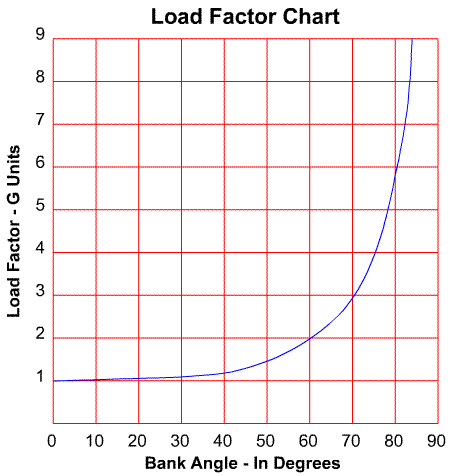|
|
|
Load factor is the ratio of the total air load acting on the airplane to the weight of the airplane, or in other words, the proportion between total lift, produced and total weight.

Load factors are expressed in terms of "G". Airplanes are designed and certificated in specific categories and must be demonstrated to be capable of withstanding the following loads:
| Normal category (no acrobatics or spins) | +3.8G -1.5G |
| Utility category (mild acrobatics or spins) | +4.4G -1.8G |
| Acrobatic category | +6.OG -3.OG |
In a constant altitude turn, load factor is the resultant of two forces, centrifugal force, which opposes turning force, and gravity. The steeper the bank, the greater will be the centrifugal force, hence the higher the load factor.

By multiplying the gross weight and load factor the actual load on the airplane can be determined.
GW X LF = Actual load
2500 X 1.5 = 3750
An airplane may be stalled at any airspeed and attitude. When the critical angle of attack is reached the smooth flow of air over the airfoil breaks up and tears away producing a stall. One very important fact is that the critical angle of attack of a given wing remains the same regardless of weight, dynamic pressures, airspeed, etc. and the critical angle of attack at which a given aircraft stalls is dependent on the design of the wing. A stall entered from straight and level flight or an unaccelerated straight climb will not normally produce load factors in excess of one G. However, as the stall occurs the load factor may be reduced toward zero G. No appreciable increase in load factor or stall speed occurs at bank angles up to 30 degrees. However, above 45 degrees the increase is rapid and pronounced. The stall speed at any given angle of bank can be predicted simply by multiplying the stall speed, for wings level lift equals weight flight, by the square root of the load factor corresponding to the angle of bank. As an example, an aircraft with a normal stall speed of 60 knots would stall at about 85 knots in a 60 degree banked turn. In a 75 degree banked turn the stall speed will have doubled. Changes in weight also have an effect on stall speed, and as a general rule of thumb it can be stated that a 2% change in weight will cause a 1% change in the stall speed.
As previously mentioned, the stall occurs at the critical angle of attack. The wing is designed with a geometrical twist, or "washout" which decreases the local angles of attack near the tips and causes the stall to begin near the wing root. In addition the wing is varied in camber and thickness throughout its length. As the wing approaches the stall near the root section, considerable warning in the form of tail buffeting will occur, and at the same time the ailerons will retain control effectiveness.